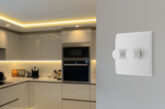
Zano’s technical team recounts three recent queries it faced and why each could have been resolved by using the right dimming products.
On an almost daily basis, we hear from contractors who encounter problems with LED dimming and, more often than not, the problems they face all derive from the same set of problems:
LED inrush current
Compatibility
Labelled wattage
A mixture of all three.
To demonstrate, we talk you through three scenarios three electricians all faced in the same week. With each scenario faced, our technical team could have helped avoid the problem altogether by being brought in by the contractor at the beginning, rather than the end.
SCENARIO #1: THE RESTAURANT
With 56 lamps on one single circuit, a restaurant due to open the very next day, and a grid dimmer that wasn’t working as expected – this scenario left one electrician in a very tight spot.
With a wattage range of 5-250W/VA, Zano’s ZGRIDLED+ is a grid dimmer that can deal with much more than most. However, with 56 lamps on one single circuit it wasn’t hard to figure out what was causing problems with this dimmer.
Take 56 LED lamps, all listed as 4.4W on the box – and you might be fooled into thinking that the total load is just under 250W/VA. But, unless you’ve calculated the true load of the circuit – how much power each lamp actually consumes and factor in inrush current (that spike in current being drawn by the LED power supply) – you’ll be left with a much larger load than a 250W/VA dimmer can cope with.
Solution: Unfortunately, with the restaurant due to open the next day there wasn’t much Zano could do at this stage of the project. The ZBARLED1000 would have been the ideal product for this sort of load, but it was too late into the project at this point to install one of the remote dimming packs.
Zano take away: 56 lamps on one single circuit is a long shot for even the most, and to make matters worse, an LED’s inrush current is often not included in the wattage on the label. In Zano’s testing lab, we’ve seen lamps regularly quadruple their labelled wattage, with one 5W/VA downlight reaching 20W/VA.
Not every lamp has such a significant inrush current: some LEDs spike only slightly above their labelled wattage, with many lamps from reputable LED manufacturers keeping inrush to a minimum. When calculating the wattage of your installation, leave a generous inrush allowance or have your lamps tested independently before fitting on site to ensure complete compatibility with the chosen dimmer.
SCENARIO #2: CHANDELIER
With a bespoke chandelier correctly installed and connected to Zano’s multi-point ZSMARTLED through 3-core and earth wiring – two electricians were left in a state of confusion as to why, when turned on, the chandelier (and the dimmer) completely shut down.
ZSMARTLED is designed as a dimmer for LED, and it didn’t take the tech-team long to uncover that the problem here was with the lamps. Tungsten lamps were being used and they completely shut down having been paired with a dimmer designed for LED.
Solution: When using a Zano Controls digital dimmer, all you need to do is pair the dimmer with good quality, dimmable, LED lamps. In this case the tungsten lamps were swapped out and replaced with good quality, dimmable LEDs.
Zano take away: Check that the correct light fittings have been supplied/bought prior to installation and do your calculations before costing up the project. When using a Zano LED digital dimmer, make sure you purchase good quality, dimmable lamps from reputable LED brands.
SCENARIO #3: THE OFFICE
The final electrician had installed eight 600 x 600 LED panels in an office environment and paired them with Zano’s ZBARLED remote dimming pack. Despite this being the right dimming solution – ZBARLED can cope with the huge inrush current generated by the LED drivers attached to LED panels – the LED drivers installed in this instance were causing the ZBARLED to shut down completely.
Now, the ZBARLED can cope with up to 100A of inrush, but any more than that and extra ZBARLEDs need to be added to the circuit. The technical team investigated the problem and, unsurprisingly, found that the LED drivers on these panels were extremely aggressive. Also, in this instance, they were generating more than 100 amps of inrush, despite on-the-box advertising suggesting that the light output of these panels was 40W LED.
Solution: A simple but costly fix (if not previously factored in). In this case the electrician had to add an additional ZBARLED to the circuit – it solved the problem in no time, but the additional ZBARLED remote dimming pack hadn’t been quoted for at the beginning of the project.
Zano take away: Drivers for LED panels are notoriously difficult to dim, not because they can’t be dimmed but because there’s a huge disparity between the wattage listed on the LED panels box and the power it consumes at start-up, with many manufacturers listing lower amperage for the same wattage drivers.
ZBARLED is a remote dimming pack that can cope with even the most challenging of LED drivers, providing you’ve made sure the installation is calculated correctly, and tested before quoting for the project. Adding an additional ZBARLED remote dimming pack to the circuit is a simple solution to cope with more than 1000W/VA LED – as long as it’s planned for.
From project planning to lamp testing and everything in between, Zano solves LED dimming problems.
Download the Zano Controls mini catalogue here.














